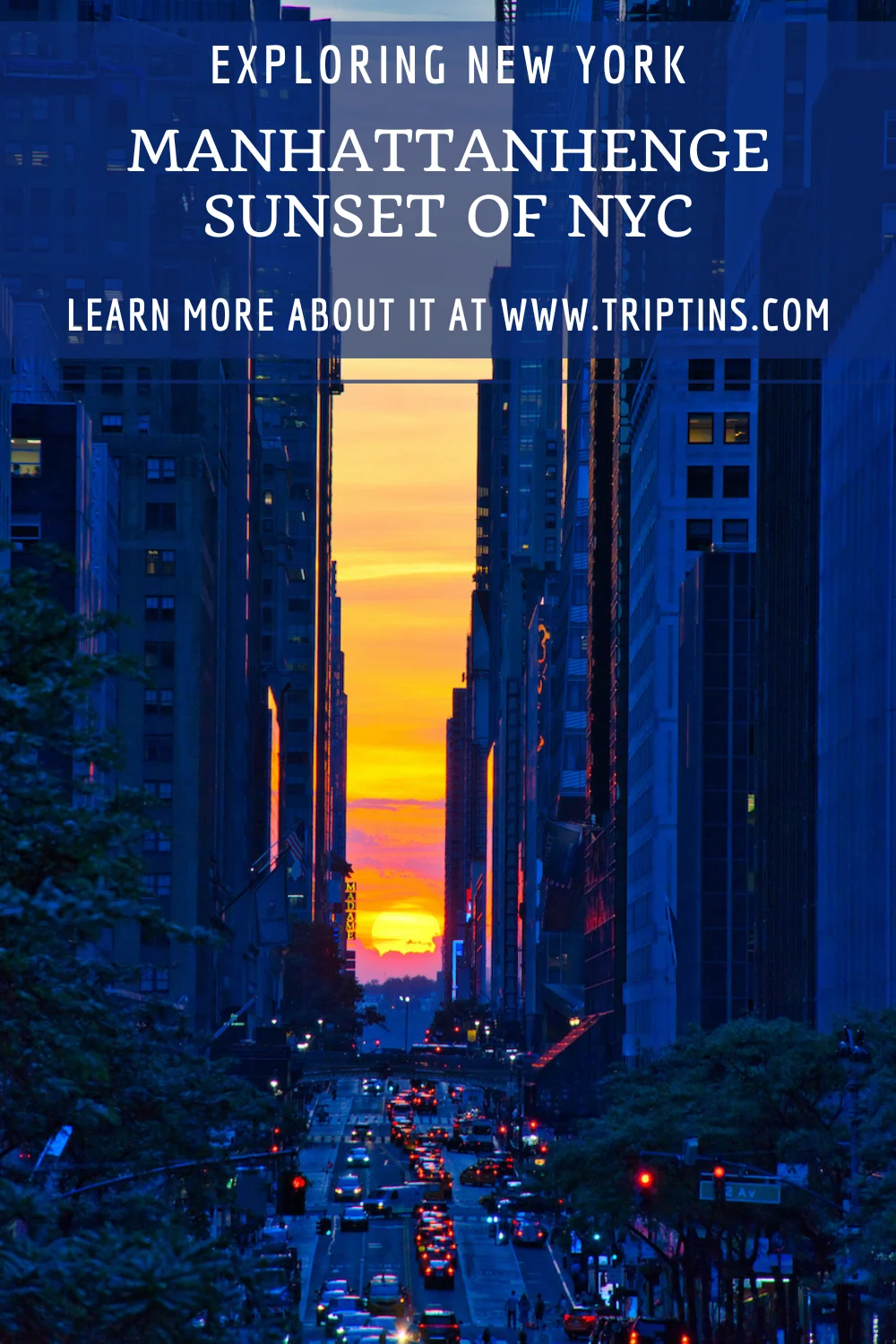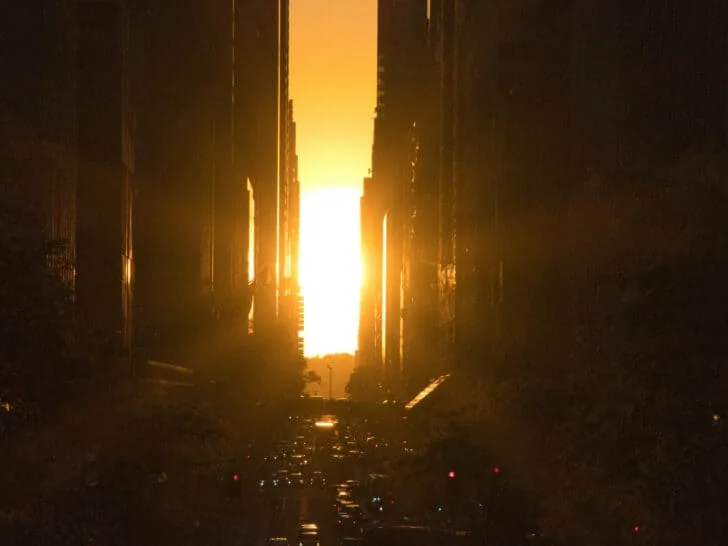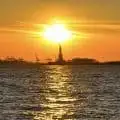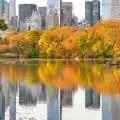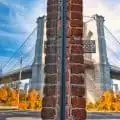Two times a year, a phenomenon occurs when the sunset aligns perfectly with the grid of New York City. This is called Manhattanhenge.
Made popular by Neil deGrasse Tyson, Manhattanhenge is a photographer’s dream as you get that rare shot of the sun setting right down the streets of NYC with skyscrapers on either side.
This Manhattanhenge guide is here to help you understand what this phenomenon is all about, and give you some helpful tips when going about seeing it for yourself.
* Affiliate Disclosure: This post may contain affiliate links, which means I may receive a commission if you make a purchase through the links provided, at no additional cost to you. Thanks for supporting the work I put into TripTins!
1) What is Manhattanhenge?
When looking at a map of New York City, you may realize that much of it lays on a perfect grid. There are avenues that go north to south and streets that go east to west.
Now, the sun itself is constantly moving and setting in different locations throughout the year. Each day, the sunset will move just a few degrees compared to the day prior.
However, there are two occurrences each year when the sunset will align perfectly with the east/west streets of Manhattan.
This is called Manhattanhenge (or as some say, the Manhattan Solstice).
Manhattanhenge happens in late May and early July. For two days during each of those occurrences there will be a half-sun Manhattanhenge and a full-sun Manhattanhenge.
The full sun is when the entire sun will be centered just above the horizon. And the half sun is when just half of the sun will be centered above, with the other half below the horizon.
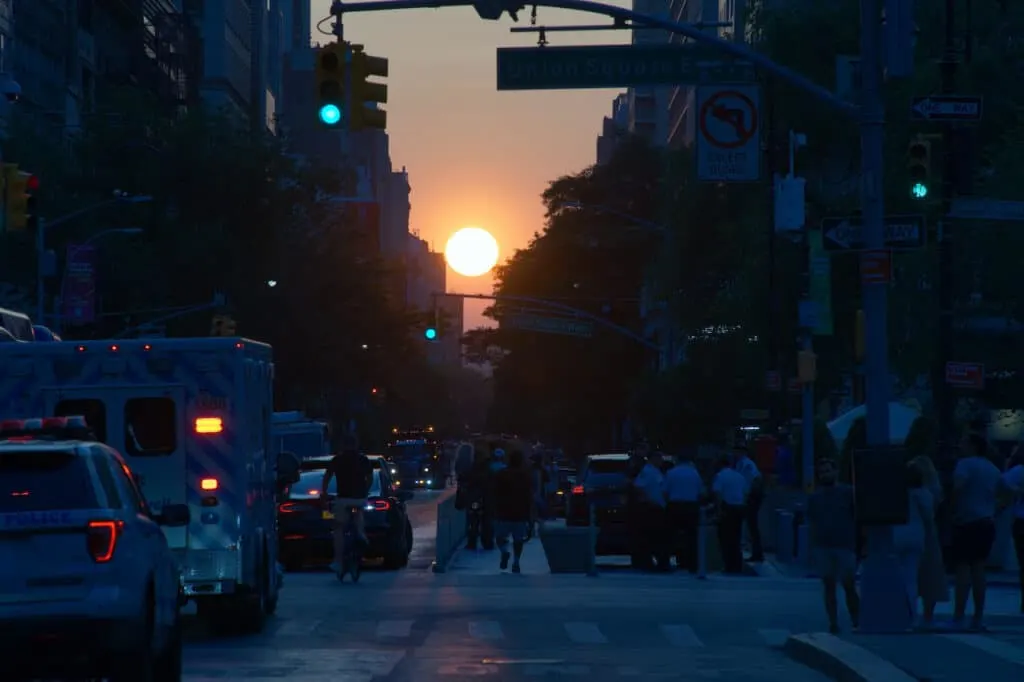
Manhattanhenge Definition
The term Manhattanhenge comes from Neil deGrasse Tyson, who derived it from Stonehenge.
Stonehenge (a historic monument in England), was built in a way that during the summer solstice, the sunrise would perfectly align with some of the stone structures.
Since the term was coined, “Manhattanhenge” has been the name used for years to describe this occurrence.
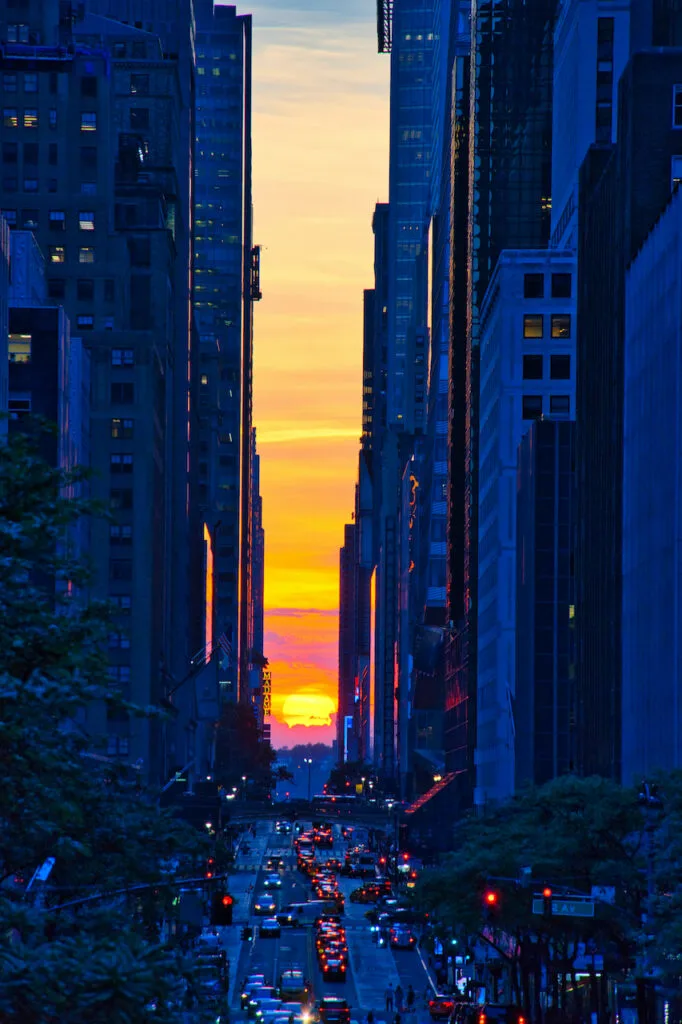
2) Understanding Sunset
Before getting into the dates & best places to see Manhattanhenge, I wanted to explain sunset locations a bit more.
As it gets later into the first half of the year, the sun continues to set more and more northbound as we approach summer solstice (June 21).
The reason that Manhattanhenge does not occur on the summer solstice date, is because the Manhattan street grid is rotated 29 degrees east. So, instead it occurs just before and after the solstice itself.
It is around the end of May when the first Manhattanhenge happens. First will come the half sun date, followed by the full sun date.
Once the May Manhattanhenge dates pass, the sun continues to set further north, and the sunset will no longer be aligned with the streets of NYC.
However, once June 21 comes along, the sunset will then begin to come back southbound. That is when you will get to catch the second Manhattanhenge in early July (first the half sun, and then the full sun).
After the second Manhattanhenge, the sun then continues its way southbound until the wintertime, before repeating the process over the following year.
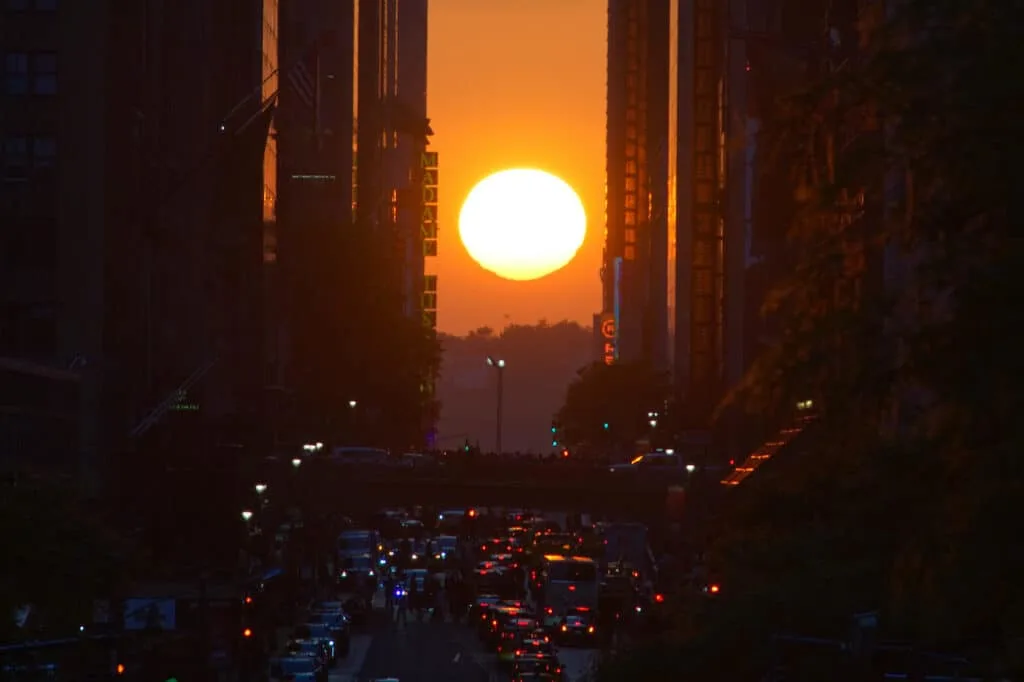
3) Manhattanhenge Dates 2023
For 2023, you can expect Manhattanhenge to occur on the following dates:
- May 29, 2023: Half Sun
- May 30, 2023: Full Sun
- July 12, 2023: Full Sun
- July 13, 2023: Half Sun
You will want to be ready in your spot around 15-20 minutes prior to sunset, as you get to see the whole sunset process take shape. For those photographers out there, that wait time may be much longer (more on that soon).
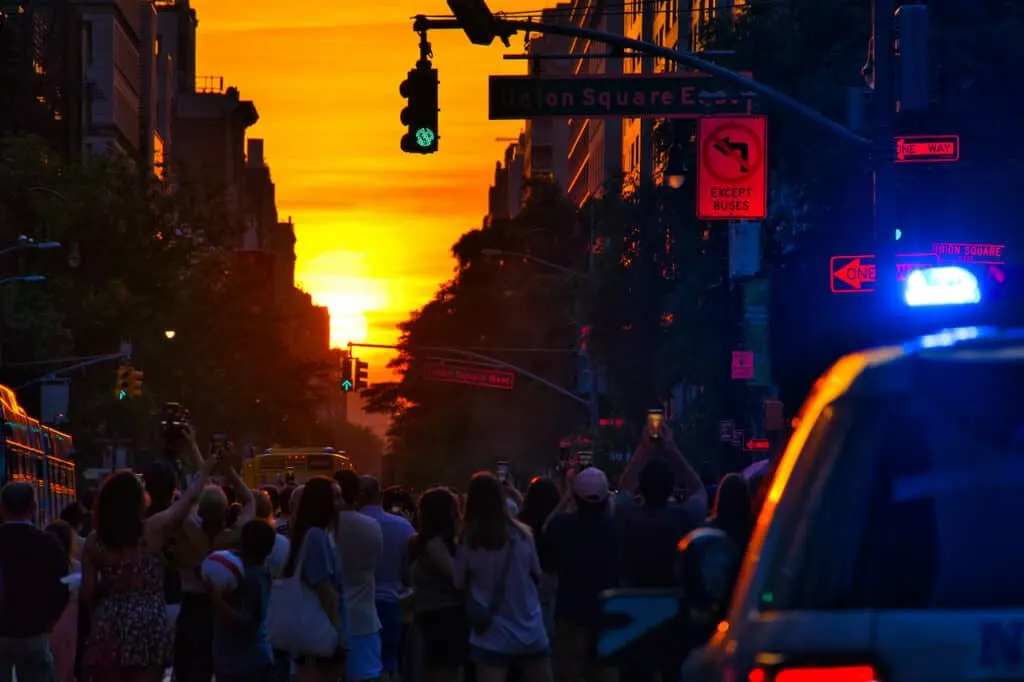
Pre-Post Manhattanhenge Tip
Now, when most people hear the exact Manhattanhenge date, that is when everyone floods the streets and spends hours waiting for a photograph.
Few realize though that you don’t need to be there on the exact date. Instead you can experience a very similar phenomena on the dates following & prior to the occurrence.
Here are some recommendations to avoid some of the crowds:
-> For the first Manhattanhenge in May, I would recommend taking in sunset within the week after the official dates (the sooner the better). During the week after May Manhattanhenge, the sun is still so close to the horizon, and you can still photograph a similar (but not perfect) aligned shot of the sun centered with the city streets.
-> For the second Manhattanhenge in July, I would recommend taking in sunset within the week before the official dates. Similarly to above, you should be able to get comparable photographs of the sun aligning with the streets.
During these days that are before/after official Manhattanhenge, you will find that the sun is not necessarily setting on the grid. However, the sun is so close to the horizon, that you still get a beautiful view of sunset (see photo below).
I would not as much so recommend going prior to May Manhattanhenge or after July Manhattanhenge, as the sun won’t align with the streets. Although you could give it a shot within 1-2 days.
The closer to the official dates the better!
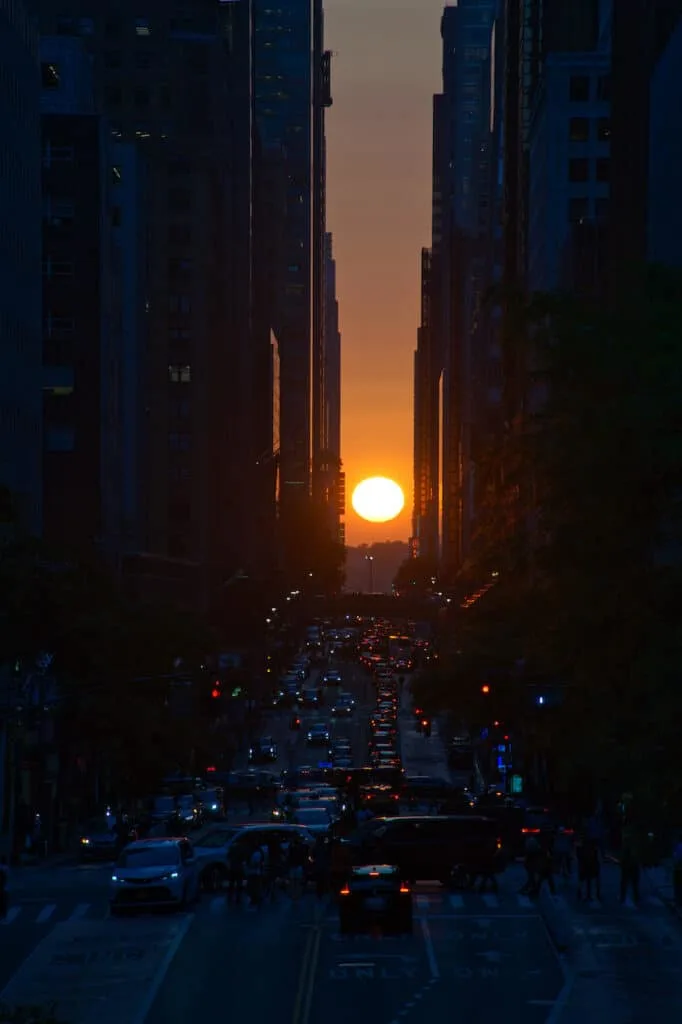
4) Manhattanhenge Best Location & Streets
If you know New York, you know that there are so many cross streets within the city. To better help you decide on a location to witness Manhattanhenge, it is recommended to stick to the “two way” streets.
Most of Manhattan is filled with narrow one-way streets. However, there are some streets going east to west that are two-way streets. These streets are going to be wider, and therefore give you a better overall view of Manhattanhenge occurring.
In addition, you may want to think about getting elevated off of the street level. While you can certainly take photos from the street, the angle won’t be as great and it can be more dangerous (since you will essentially need to be standing in the street’s traffic).
Here are some of the top photo spots to enjoy Manhattanhenge from:
Tudor City Bridge
The most famous spot for Manhattanhenge photos is the elevated Tudor City Bridge on 42nd Street. This overpass is located between 2nd Avenue and 1st Avenue (east side of Manhattan).
In turn, you will get a ton of the cityscape out in front of you from 2nd Avenue all the way to the west side.
In addition, 42nd Street is an iconic street on its own. With Grand Central Station, the Chrysler Building, the Pershing Square overpass, and many other buildings & structures in view, it is a hard spot to beat.
With that said though, it is also by far the most crowded of options with people arriving many hours before sunset. People literally line up for 10+ hours with their tripods to get that perfect spot.
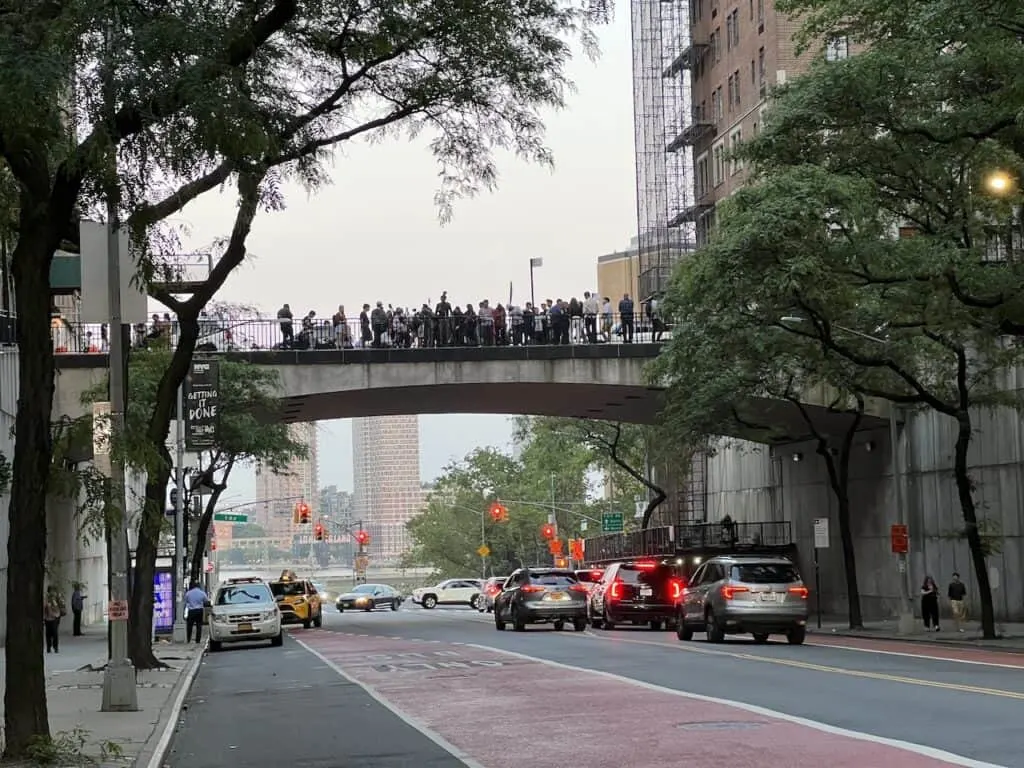
I ended up going here one day after and six days after the May Manhattanhenge. The day after, there was still a large group of people waiting for sunset (but not as hectic as the day prior – see photo above). Nearly a week after, there was still a group of about 20 people taking photos.
Below are some photos from the Tudor City Bridge of Manhattanhenge on the day after the official date:
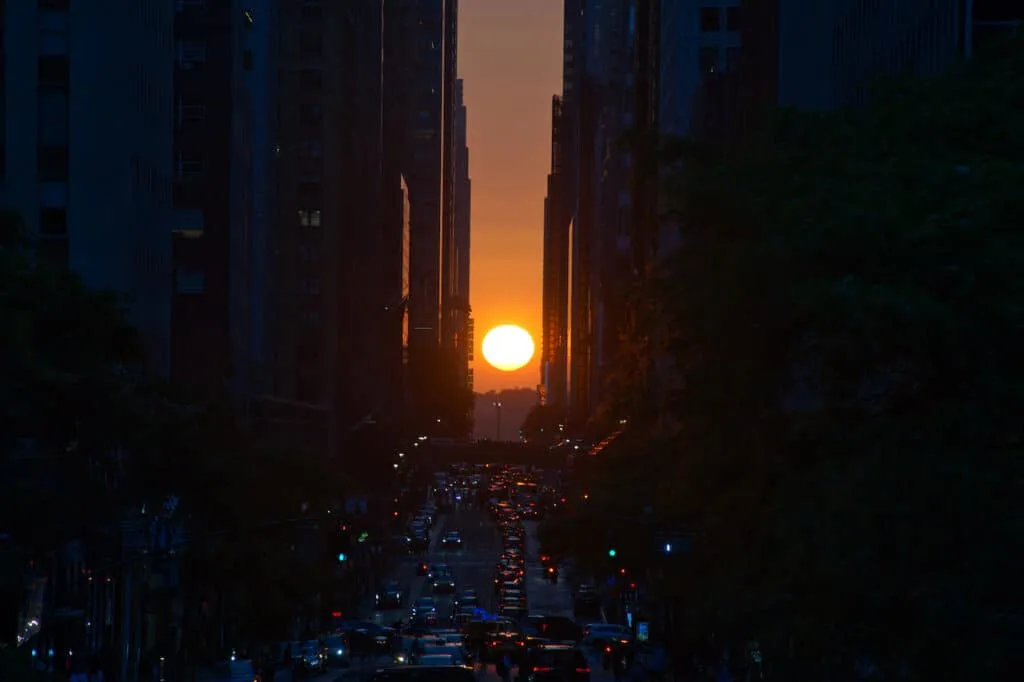
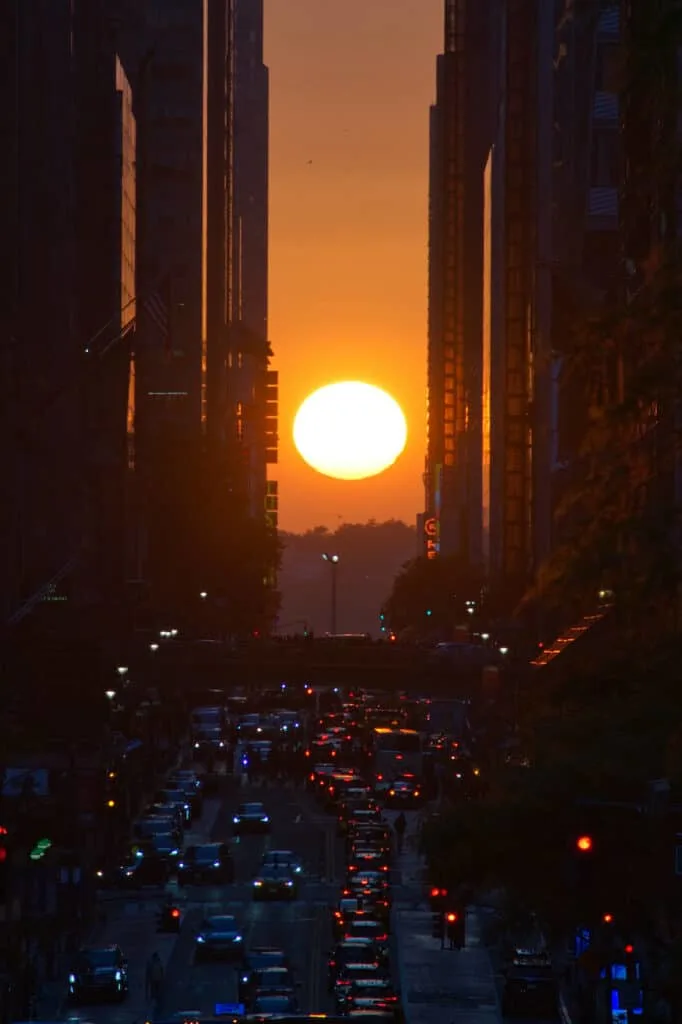
Other Manhattanhenge Locations
If the Tudor City Bridge on 42nd Street isn’t for you, below are some of the other locations I would recommend. Try and go to the eastern side of these streets (east of ~5th/6th Avenue) so you can get a clean shot of the sun surrounded by the cityscape.
- 14th Street: around Union Square
- 23rd Street: around Madison Square
- 34th Street: around Herald Square
- 42nd Street: near Grand Central or Times Square
- 42nd Street: Pershing Square Overpass*
I see 57th Street mentioned as an option too, but I do believe (based on walking in the area) that there is a building on the horizon in New Jersey that would block the sunset. Feel free to let me know if you give it a try for yourself.
*The Pershing Square Overpass is a small vehicular bridge that goes over 42nd Street from Grand Central. You can actually see it from the photos I took from the Tudor City Bridge. People do line up here as it is an elevated viewpoint. However, it can be a bit dangerous due to the lack of an official sidewalk.
You can also head to Hunter’s Point South Park in Long Island City, for a unique shot from across the East River.
Below are a couple of shots of Manhattanhenge from 14th Street and 23rd Street:
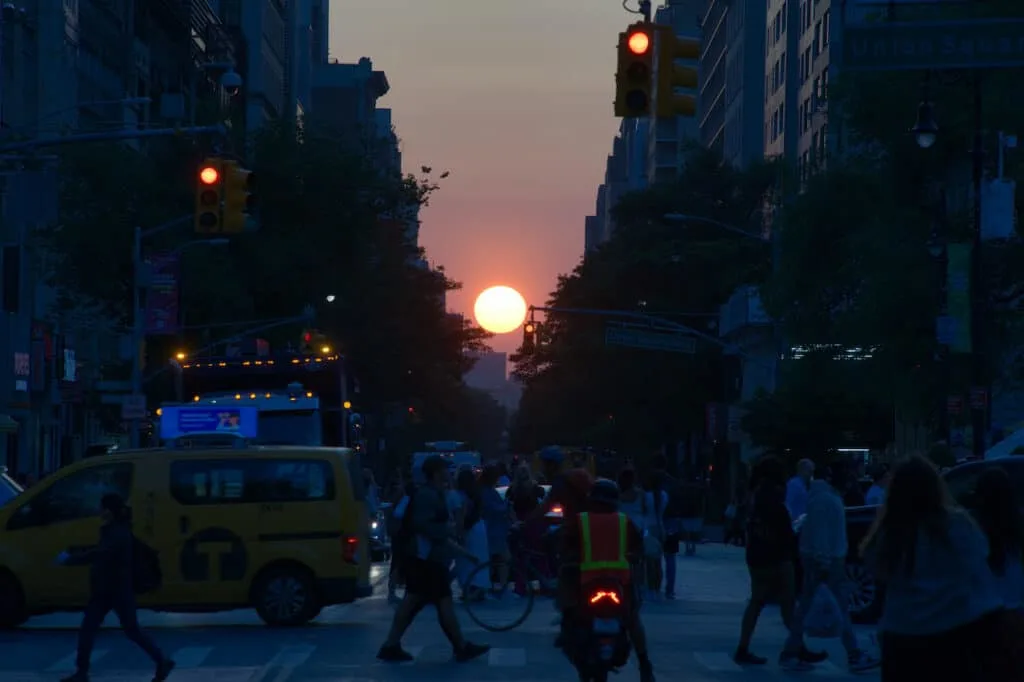
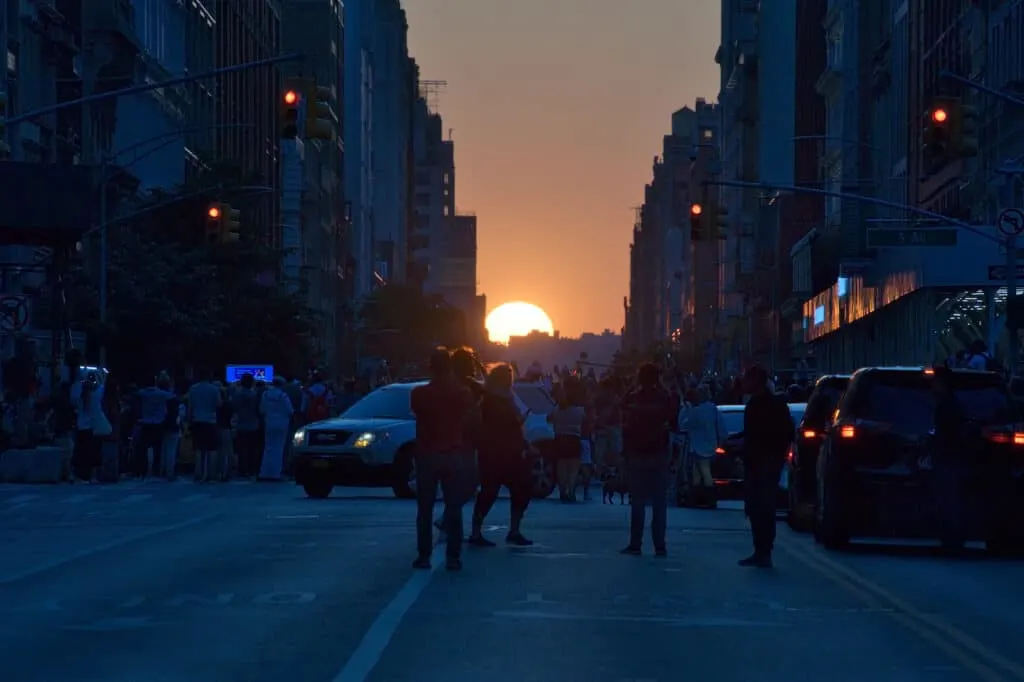
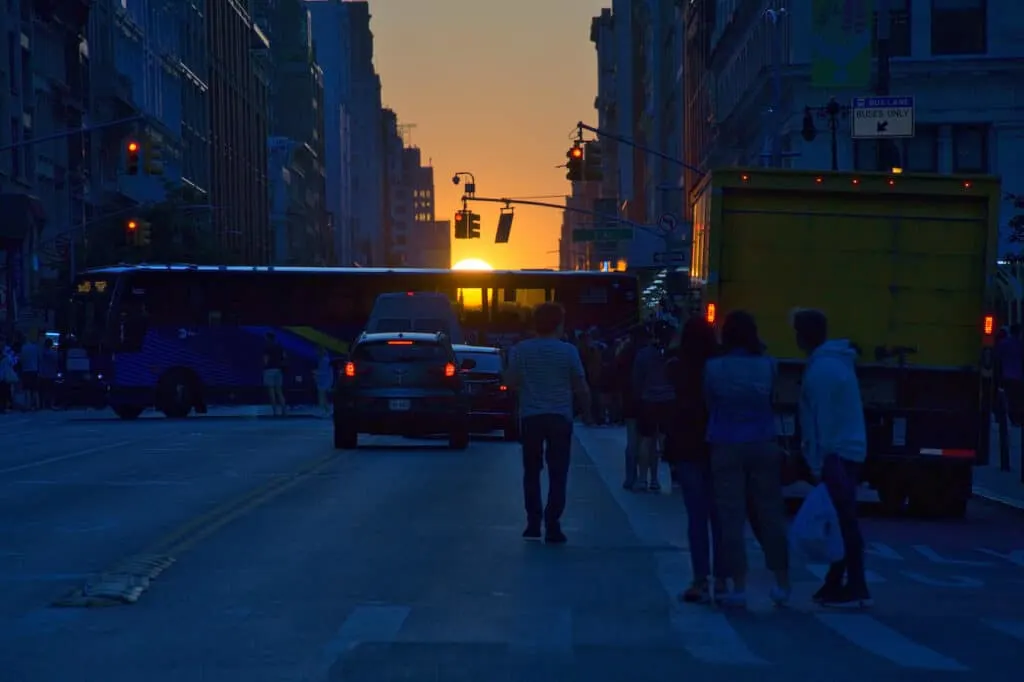
One Way Streets
Of course you can also witness Manhattanhenge from a number of lesser crowded streets all throughout the city.
However, these one way streets can get a bit trickier. That is because not every street is going to give you that view. Below are some things to know when choosing a location:
- Go Between 14th Street and 59th Street. Once you get above 59th Street, Central Park gets in the way of the grid. And below 14th Street, the west side of the city no longer contains perfectly grid streets.
- Not every street is going to work. There may be buildings, parks, trees, and other structures blocking the view. Be on the lookout before picking a spot.
- Be aware of street angles. Whether you are on a one way street or two way street, be cautious of the angles & inclines/declines of the street. These can get in the way of seeing the sunset.
- Try and stick to the east side of Manhattan (~5th Avenue), as you will get a better shot of the cityscape out in front of you on either side.
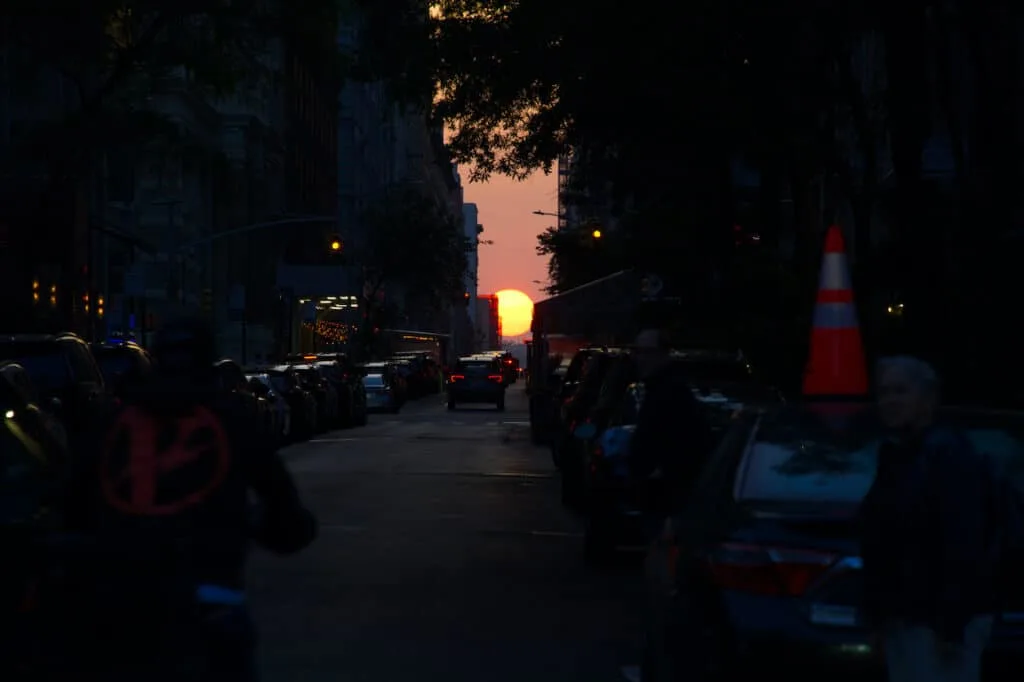
5) Manhattanhenge Viewing & Photography Tips
Whether you are a professional photographer or just want to capture the moment on your phone, below are some helpful tips when it comes to viewing Manhattanhenge.
Avoid the Crowds
As previously mentioned, if you do not care about the exact date of Manhattanhenge, I would recommend visiting just after the May date and just prior to the July date.
This way you can still get very similar photographs without the need to be overwhelmed by the crowds.
If you are just looking to take in the view from the street, it should not be an issue either way. But if you are heading up to the Tudor City Bridge, this tip is definitely relevant.
Check the Weather
Unfortunately, Manhattanhenge can sometimes be ruined by the weather. If there are many clouds on the horizon, they can completely get in the way of the sunset.
Before making plans for the evening, be sure to just check the weather to better understand if it will even be worth it.
But the good news is, you can always see if the surrounding days have better weather (back to tip #1).
Tudor City Alignment
When heading to the Tudor City Bridge, be sure to try and center yourself in the middle of the street. That way your photos can be more perfectly aligned.
Bringing a tripod may actually be a hinderance in this situation unless you are one of the first ones there or have a taller tripod. Finding a spot to set it up is not always easy with the amount of people that will be surrounding you (arrive early to solve this issue – see next tip!).
Arrive Early
This is also more so just for the Tudor City Bridge, but if you decide to go on the Manhattanhenge date itself, you will want to arrive several hours early to guarantee your perfect spot. As mentioned before, I have heard that people get to the bridge 10 hours before!
The area can get 10+ people deep with lots of attempts to find the angle and shoot over someone’s shoulder. Avoid this by arriving early enough to grab your spot.
If you decide to visit just after/before the exact dates, you should still arrive ~2 hours beforehand. The further out from the official dates, the less crowded it will be (unless there is a short weather window).
Be Cautious
If you opt to view sunset from the street level, you need to be very cautious of the surrounding traffic and lights.
Combining the amount of people in the street with the cars, taxis, and busses can be a dangerous spot to be. Try to find a “safe” place to situate yourself as sunset approaches.
Be on the lookout for dividers on two way streets, where you can safely stand without the risk of getting in cars’ way.
For those photographers out there, be sure to check out some of the other top NYC photo spots during your time in the city.
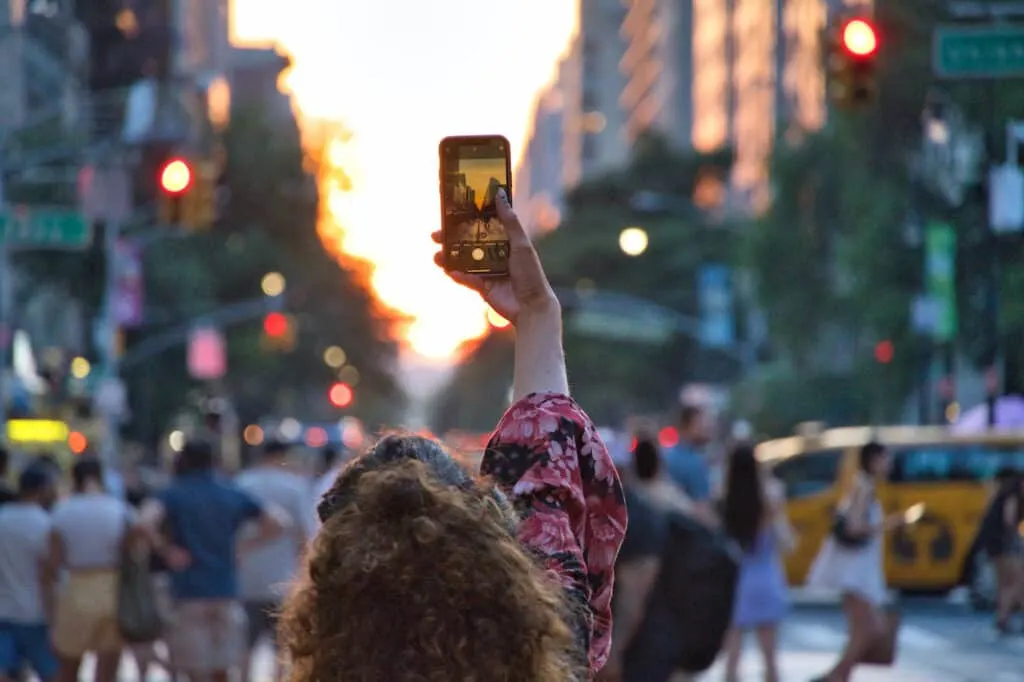
6) Manhattanhenge Sunrise
While sunset gets most of the popularity, I should note that the same phenomenon happens for sunrise too.
The dates for “Reverse Manhattanhenge” occur in the winter. This means that you will need to wake up early and bundle up to get the shot.
This time you will want to make your way to the west side of the city, so you can catch sunrise looking eastbound.
For reverse Manhattanhenge, I would recommend heading to the High Line, which opens just prior to sunrise for the January occurrence.
This elevated park is the perfect spot to grab your morning shot. Make your way above 14th Street, where you can get a nice Greenwich Village cityscape with the sun rising out in the distance.
The dates for reverse Manhattanhenge are usually around November 29 & 30, and January 11 & 12.
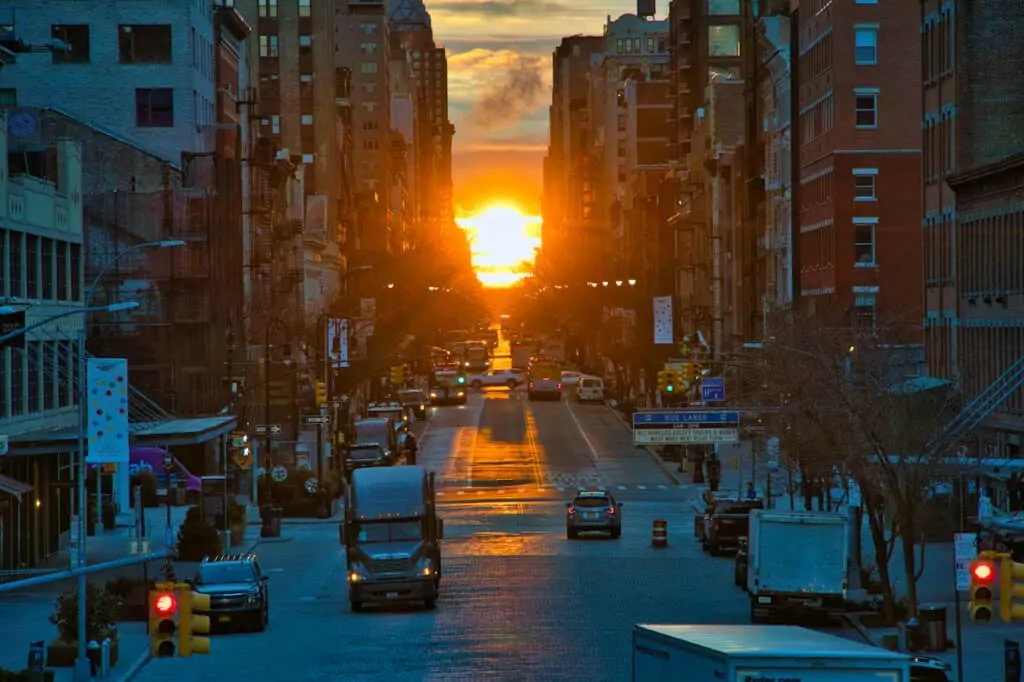
7) Manhattanhenge FAQs
To wrap up, here are some answers to the most frequently asked questions about Manhattanhenge.
Manhattanhenge occurs twice a year – once at the end of May and once in mid July. During each occurrence, there is a full sun date and half sun date (so, four “official” dates altogether).
In addition, the same phenomena happens in the winter for reverse Manhattanhenge, when the sunrise aligns with the city streets.
Manhattanhenge lasts just a handful of minutes, so you better be quick to capture those photos. As the sun comes across the horizon, it will only be perfectly centered for a minute or two before continuing along its path.
To summarize, Manhattanhenge is when the sunset aligns perfectly along the streets of Manhattan. Since the grid of Manhattan is tilted 29 degrees, the Manhattanhenge effect occurs once before the summer solstice and once after the solstice.
You can view Manhattanhenge from many of the east/west streets in Manhattan between 14th Street and 59th Street. You can also catch it from Hunters Point in Long Island City for a different perspective.
The exact moment of Manhattanhenge, as the sunset aligns perfectly with the grid, only lasts a couple minutes or so. However, there will be several more minutes when the sunset is within the city streets (just not perfectly aligned in the middle).
This goes back to the idea that the grid of Manhattan is not perfectly aligned with true west-east. Instead, the grid is titled 29 degrees northeast. This in turn creates that Manhattanhenge sunset once before the summer solstice and once after.
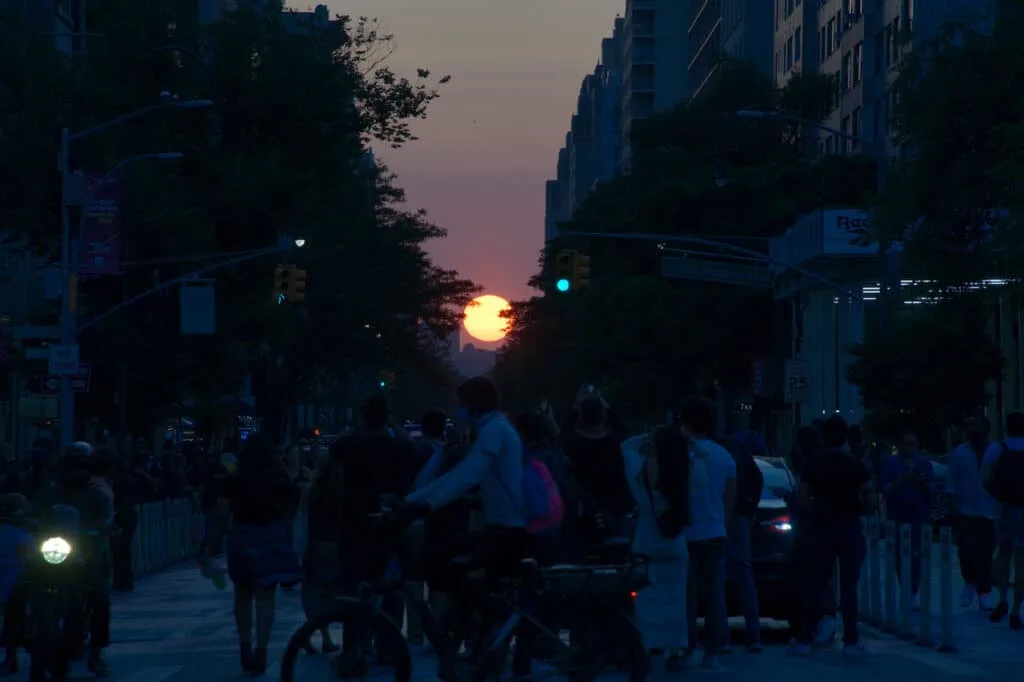
I hope by now you have a better idea on how to experience Manhattanhenge for yourself.
If you do have any questions or comments, be sure to add them in below. Also feel free to check out the other New York itineraries and guides up on the site (like this New York City Itinerary).
Have fun out there and safe travels!
